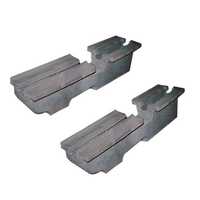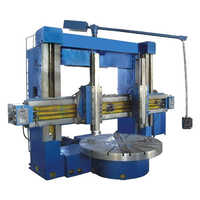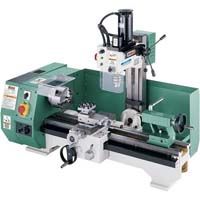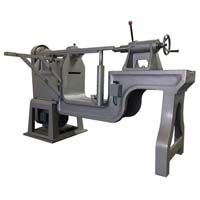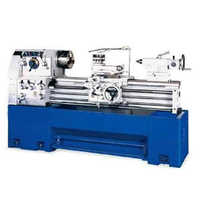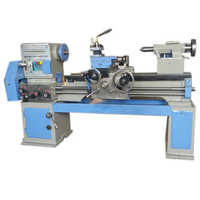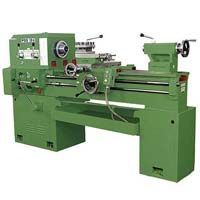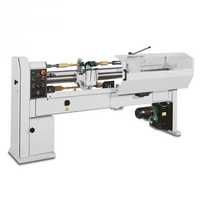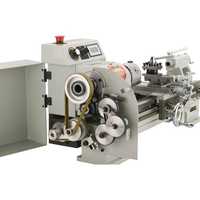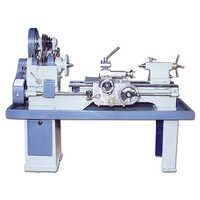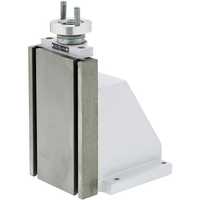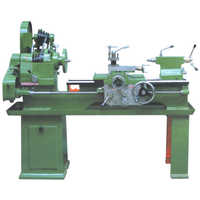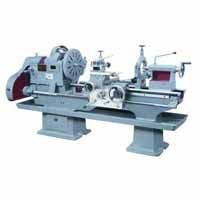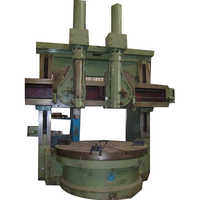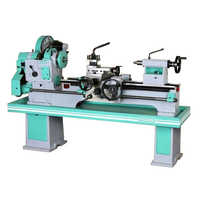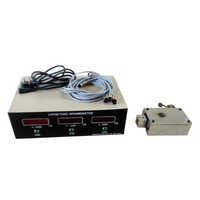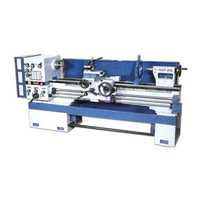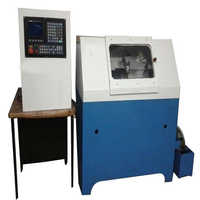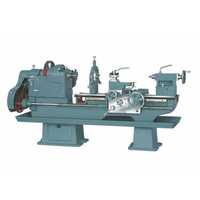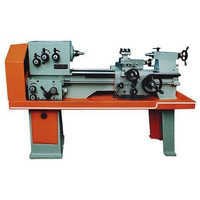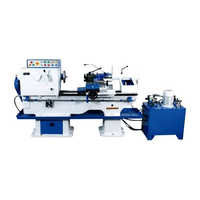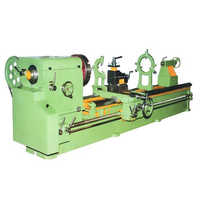Lathe Machine
(5064 products)
Top Lathe Machine Categories
Explore More Categories
Semi-Automatic Lathe Machine - Automatic Grade: Semi Automatic
MOQ - 1 Unit/Units
Product Type - Other
Material - Mild Steel
Automatic Grade - Semi Automatic
5 Years
Business Type: Manufacturer | Exporter
TIRUPATI CNC PRODUCTS
Extra Heavy Duty Geared Lathe Machine - Color: Green
Price: 400000 INR (Approx.)/Unit
MOQ - 1 Unit/Units
Product Type - Horizontal
Material - Metal
Feature - High Performance, Stable Performance
6 Years
Business Type: Manufacturer | Supplier
KAHAAN ENTERPRISES
Made in India
Geared Lathe Machine
4 Years
Business Type: Manufacturer | Exporter
BERLIN MACHINERIES PRIVATE LIMITED
Made in India
Extra Heavy Duty Lathe Machine
Price: 950000 INR (Approx.)/Unit
MOQ - 1 Unit/Units
10 Years
Business Type: Manufacturer | Distributor
UMA ENTERPRISE
Made in India
Automatic All Geared High Speed High Precision Lathe Machine
Price: 710000 INR (Approx.)/Piece
MOQ - 01 Piece/Pieces
Product Type - Lathe Machine, Other
Material - Mild steel
Automatic Grade - Automatic
4 Years
Business Type: Manufacturer | Distributor
PENTAGON MACHINES AND TOOLS
Indian Inquiries Only
Light Duty Lathe Machine
Price Trend: 65000.00 - 85000.00 INR (Approx.)/Piece
MOQ - 1 Piece/Pieces
14 Years
Business Type: Manufacturer | Exporter
INTIMATE MACHINE TOOLS
Bearing Turning Lathe Machine
10 Years
Business Type: Manufacturer | Distributor
CIXI HOTO METALLIC PRODUCT CO.,LTD
Made in India
Semi Automatic Single Shaft Lathe Machine
MOQ - 1 Unit/Units
Product Type - Other, Lathe Machine
Material - Stainless Steel
CNC Or Not - Normal
Business Type: Manufacturer | Supplier
TECHNO-MECH MACHINE TOOLS
Made in India
Blue Ec Series Geared Heavy Duty Lathe Machine
Price: 2205700 INR (Approx.)/Unit
MOQ - 1 Unit/Units
Material - Mild Steel
Voltage - 220-440 Volt (v)
Color - Blue
2 Years
Business Type: Manufacturer | Supplier
BHAVYA MACHINE TOOLS LLP
Automatic Gear Lathe Machine
Price: 350000 INR (Approx.)/Unit
MOQ - 1 Unit/Units
Product Type - Other, Lathe Machine
9 Years
Business Type: Distributor | Exporter
VIKAS MACHINERY AND AUTOMOBILES
Made in India
Automatic Pedestal Lathe Machine
Price: 200000 INR (Approx.)/Unit
MOQ - 1 Unit/Units
Product Type - Other
Material - Metal
Automatic Grade - Automatic
4 Years
Business Type: Manufacturer | Exporter
ASHU ENTERPRISES
Made in India
Semi Automatic Center Lathe Machine
Price: 670000.00 INR (Approx.)/Unit
MOQ - 1 Unit/Units
Color - Pink and White
Product Type - Other
Material - Staleness Steel
10 Years
Response Rate: 82.43%
Business Type: Manufacturer | Distributor
NUTECH MECHATRONICS PVT. LTD.
Made in India
Light Duty Lathe Machine
Price Trend: 5000-100000 INR (Approx.)/Piece
MOQ - 1 Piece/Pieces
4 Years
Business Type: Manufacturer | Distributor
POONAWALA MACHINE TOOLS
Made in India
lathe machine length -6 feet
Price: 5000000 INR (Approx.)/Number
MOQ - any Number
Material - CI
Graphic Format Supported - AI
Automatic Grade - Other
2 Years
Business Type: Manufacturer
SAGAR MACHINE TOOLS
Made in India
Automatic 14 Feet Extra Heavy Duty Gear Head Lathe Machine
Price: 2500000 INR (Approx.)/Piece
MOQ - 1 Piece/Pieces
Product Type - Horizontal
Material - Metal
CNC Or Not - Normal
2 Years
Business Type: Manufacturer | Distributor
Ganesh Machine Tools
Made in India
Automatic Heavy Duty Lathe Machine
MOQ - 1 Piece/Pieces
Product Type - Heavy Duty Lathe Machine, Other
Material - Mild Steel
CNC Or Not - CNC
4 Years
Business Type: Manufacturer | Exporter
RANGANI ENGINEERING PVT. LTD.
Made in India
Semi Automatic Norton Type Lathe Machine
Price: 125000 INR (Approx.)/Unit
MOQ - 1 Unit/Units
Material - Metal
Automatic Grade - Semi Automatic
Voltage - 240 Volt (v)
6 Years
Business Type: Manufacturer | Exporter
SUPERB TECHNOLOGIES
Made in India
Semi Automatic 5.5 Feet Heavy Duty All Geared Head Lathe Machine
Price: 2,80,000 INR (Approx.)/Piece
MOQ - 1 Piece/Pieces
Product Type - Vertical
Material - Mild steel
Automatic Grade - Semi Automatic
2 Years
Business Type: Manufacturer | Exporter
INDIA MACHINE TOOLS
Made in India
Geared Lathe Machine - Automatic Grade: Semi Automatic
Price: 95000 INR (Approx.)/Piece
MOQ - 2 Piece/Pieces
Product Type - Horizontal
Material - Metal
Graphic Format Supported - Other
4 Years
Business Type: Manufacturer | Exporter
MICRO TECHNOLOGIES
Semi Automatic Ld-1 Light Duty Lathe Machine
MOQ - 1 Unit/Units
Material - Stainless Steel
CNC Or Not - CNC
Automatic Grade - Semi Automatic
1 Years
Response Rate: 91.89%
Business Type: Manufacturer | Exporter
QUALITY MACHINE PRODUCTS
Made in India
Stable Performance Single Spindle Automatic Lathe Machine
MOQ - 1 Unit/Units
Material - Metal
Feature - High Efficiency, Stable Performance
9 Years
Business Type: Manufacturer | Supplier
SHARDA INDUSTRIES
Made in India
Precision Lathe Machine
Price: 320800 INR (Approx.)/Piece
MOQ - 1 Piece/Pieces
16 Years
Business Type: Manufacturer | Supplier
Atul Machine Tools
HMT Vikram All Geared Lathe Machine
Price: 250000 INR (Approx.)/Piece
MOQ - 1 Piece/Pieces
13 Years
Business Type: Supplier | Trading Company
K. N. MACHINE TOOLS PVT. LTD.
Indian Inquiries Only
Made in India
Automatic Industrial Geared Lathe Machine
Price: 400000 INR (Approx.)/Piece
MOQ - 1 Piece/Pieces
Color - Blue-Grey
Product Type - Horizontal
Material - Cast Iron
2 Years
Business Type: Manufacturer | Exporter
ESS KAY LATHE & MACHINE TOOLS
Made in India
Semi Automatic Gear Head Lathe Machine
Price: 230000 INR (Approx.)/Unit
MOQ - 10 Unit/Units
Material - Stainless Steel
CNC Or Not - Normal
Automatic Grade - Semi Automatic
2 Years
Business Type: Manufacturer | Distributor
LEADER MACHINE TOOLS
Automatic Bhawani Lathe Machine
Price: 10000 INR (Approx.)/Piece
MOQ - 1 Piece/Pieces
Product Type - Other, Lathe Machine
Material - Cast Iron
CNC Or Not - Normal
6 Years
Business Type: Manufacturer | Supplier
Bhawani Industries Private Limited
Green Light Duty Lathe Machine
Price Trend: 100000.00 - 500000.00 INR (Approx.)/Piece
MOQ - 1 Piece/Pieces
Material - Lathe Machine
Voltage - 220-240 Volt (v)
Feature - High Performance, Low Noise
13 Years
Business Type: Manufacturer | Distributor
AKSHAR MACHINE TOOLS
Automatic Cnc Lathe Machine
Price: 1100000 INR (Approx.)/Piece
MOQ - 1 Piece/Pieces
Color - Green
Product Type - Other, CNC Lathe Machine
Material - MS
2 Years
Business Type: Manufacturer | Supplier
H. P. Singh Machinery Pvt. Ltd.
Lathe Machine Manufacturers | Suppliers in India
| Company Name | Location | Member Since |
|---|---|---|
| Atul Machine Tools | Rajkot, India | 16 Years |
| Intimate Machine Tools | Rajkot, India | 14 Years |
| K. N. Machine Tools Pvt. Ltd. | Kolkata, India | 13 Years |
| Akshar Machine Tools | Rajkot, India | 13 Years |
| Uma Enterprise | Rajkot, India | 10 Years |
| Cixi Hoto Metallic Product Co.,Ltd | Ningbo, China | 10 Years |
| Nutech Mechatronics Pvt. Ltd. | Rajkot, India | 10 Years |
| Vikas Machinery And Automobiles | Rajkot, India | 9 Years |
| Sharda Industries | Vadodara, India | 9 Years |
| Kahaan Enterprises | Rajkot, India | 6 Years |
Why Lathe Machines Are So Popular?
- Cutting and shaping of metals and wood
- Decorative Turing
- Paper and Steel Mills
- mining sector
- Textile Sector
Working Principle of Lathe Machine
- An H-shaped casting that is put on the top of the lathe shaft is the saddle. It supports the tool post, complex rest, and cross slide.
- The cross slide, which is fixed to the top of the saddle, gives the cutting tool a mounted or motorized cross movement.
- The tool base and the cutting tool are supported by the compound rest, which is attached to the top of the cross slide.
- The cutting tool or tool holder is rigidly clamped at the correct height about the work center line by the tool post, which is fixed on the compound rest.
- The gears, clutches, and levers necessary to move the carriage or cross slide are housed in the apron, which is attached to the saddle.
Types of Lathe Machine
Milling Machines Vs Lathe Machines
Uses Of Lathe Machine
Related Categories
Agarbatti Making Machines
Agricultural Machines & Tools
Bag Closing Machine
Bag Making Machine
Bag Packaging Machines
Banking Automation Products
Bending Machines
Billing Machine
Biscuit Making Machinery
Block Making Machine
Blow Moulding Machines
Box Making Machines
Braiding Machine
Brick Making Machine
Briquettes Making Machines
Briquetting Plants
CNC Machines
Cable Machinery
Carton Folding & Gluing Machines
Cashew Processing Machine
Cement Plant Machinery
Ceramic Machinery
Chapati Making Machines
Chemical Machinery
Chemical Processing Plants
Chuck
Coating Machine
Coil Winding Machines
Coir Machinery
Compression Testing Machines
Concrete Batching Plant
Confectionery Machinery
Construction Equipment
Construction Machinery
Cotton & Synthetic Spinners
Cutting Machine
Cylindrical Grinding Machinery
Dairy Equipment
Dairy Products Machinery
Decorative Laminate Machinery
Diamond Cutting Blades
Diamond Cutting Discs
Diamond Cutting Machines
Diamond Cutting Tools
Diamond Cutting Wheels
Diamond Grinding Wheel
Diamond Polishing Pads
Diamond Polishing Wheels
Dispenser Machine
Earth Moving Equipment & Machinery
Electrical Cable Machine
Embroidery Machine
Extraction Plants & Machinery
Extruder
Filter Machinery
Fishery Machinery
Flexo Printing Machinery
Flour Mill Machinery & Accessories
Food Processing Machinery
Footwear Machinery
Forest Machinery
Fruit & Vegetable Processing Machine
Gas Generation Equipment
Glass Processing Machines
Granite Processing Machinery
Grinding & Milling Machinery
Home Sewing Machine
Horticulture, Gardening & Irrigation Machinery
Hosiery Machinery
Ice Cream Machines
Ice Cream Plants
Industrial Gas Plants
Industrial Machinery & Parts
Injection Moulding Machine
Jewelry Making Tools & Machinery
Jute Mill Machinery
Knitting Machinery
Knitting Needles
Label & Sticker Labeling Machine
Lamination Machinery
Lamp Making Machinery
Laser Cutting Machines
Lathe Machine
Leather Machinery
Liquid Filling Machines
Machine Tools
Machine Tools Accessories
Machineries
Machinery & Parts
Marine Equipment
Metallic Processing Machinery
Metallurgy Lab Equipment
Mining, Exploration & Drilling Machinery
Mosaic Tiles Machinery
Oil & Gas Field Machinery & Equipment
Oil Expeller
Oil Extraction Machine
Oil Mill Machinery
Oil Refinery Plant
Oil Seed Extraction Machinery
Other Machinery
Oxygen & Nitrogen Gas Plants
PU False Twister
Packaging Machine
Paint Manufacturing Machines
Paper Printing & Book Binding Machine
Paper, Paper Converting Machinery
Pharmaceutical Machinery
Planetary Mixer
Plant & Machinery
Plasma Cutting Machines
Plasma Welding Machines
Plastic Processing Machinery
Plastic Sealing Devices
Plywood Machinery
Polish & Polishing Material/Machinery
Polyurethane Foaming Machines
Pressure Fingers
Printing Ink Machinery
Printing Machinery
Processing Machines & Equipment
Pulverizers
Ribbon Blender
Rice Machinery
Rice Mill Machinery
Road Construction Machinery
Roll Forming Machinery
Rolling Mill Machinery
Rotogravure Printing Machine
Rotomoulding Machines
Rubber Extrusions
Rubber Machinery
Rubber Moulding Machines
Sealing Machine
Seed Processing Machinery
Sewing Machine
Sewing Machine Parts & Accessories
Shearing Machine
Shredding Machine
Shrink Wrapping Machines
Soap Making Machine
Soaps & Detergent Plants
Soda Making Machine
Sorting Machine
Special Purpose Machines
Spinning Machinery
Stamping Machine
Starch and Starch Machinery
Steel Rolling Mills Machinery
Strapping Machines
Stretch Wrapping Machines
Sugar Machinery
Tea & Coffee Machines
Textile & Garment Machinery
Textile Dyeing Machinery
Textile Finishing Machinery
Textile Machinery Spares, Components & Accessories
Textile Printing Machinery
Textile Processing Machinery
Tyres Repair & Retreading Machinery
Universal Testing Machines
Used Machinery
Vending Machine
Waste Tyre Recycling Plant
Water Jet Cutting Machine
Weaving Machinery
Weighbridge
Weighing Machines
Welding Electrode Plant & Machinery
Welding Machine
Wire Drawing Machines
Wire Machinery
Wire Winding Machines
Woodworking Machinery
Worsted Spinners
